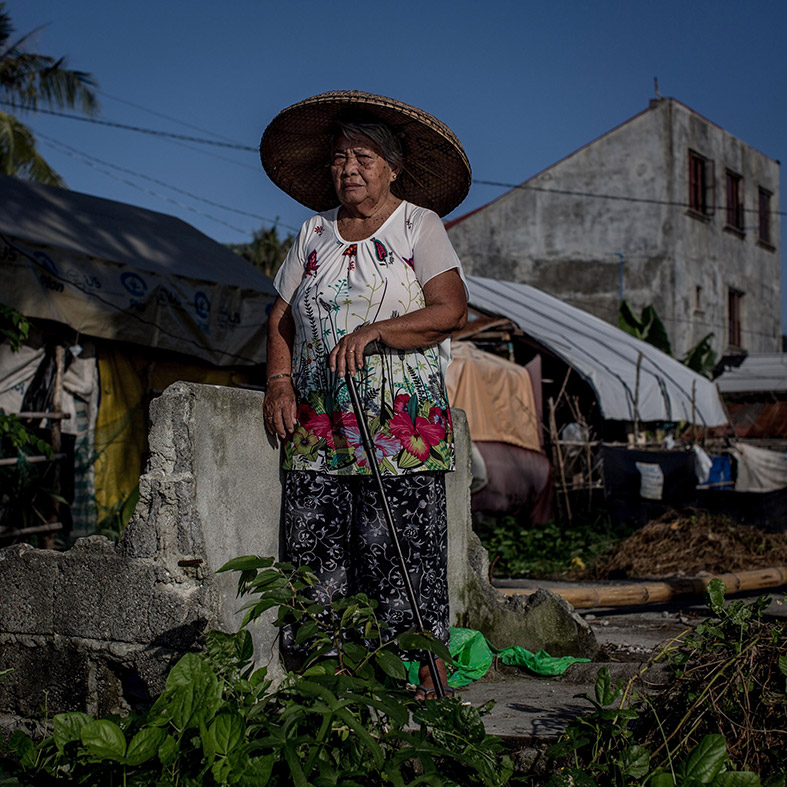- By David Sim
 November 7, 2014 10:50 BST
November 7, 2014 10:50 BST
A year after Typhoon Haiyan flattened a huge swathe of the Philippines, many survivors are struggling to rebuild their homes, especially those in No Build Zones – government-designated danger zones where future typhoons could wreck their lives again.

Josefina Gola, 79, stands outside the ruins of her home in San Antonio, Samar, Philippines. Josefina has not been able to rebuild her home as it now sits in the No Build zone and as she receives a pension she does not qualify for government rebuilding funds(Chris McGrath/Getty Images)
Haiyan's ferocious winds generated tsunami-like storm surges that swamped entire communities, leaving more than 7,300 people dead or missing. More than four million people were displaced by the storm, which destroyed or damaged more than a million houses.
The Philippine government, backed by foreign donors and aid organisations, still must resettle about 200,000 families to permanent housing sites over the next two or three years.

Mariena Delacueva stands in the ruins of her family's home in San Antonio, Samar, Philippines. Mariena looks after the property after her parents moved to Manila to find work so they can save enough money to rebuild the house(Chris McGrath/Getty Images)
The Philippines, which sees an average of 20 typhoons a year, is planning to build typhoon-resilient structures and relocate residents living in danger zones to areas which it considers safer. But a report by the Tacloban city government in October said fewer than 100 of 14,500 promised permanent homes had been built, and that thousands were still living in danger zones.
Those displaced by Haiyan, known locally as Yolanda, are housed in tents and temporary shelters while others live with relatives or in hastily erected shacks.
Chris McGrath, who photographed the devastation in the days after the typhoon hit, has returned to the Philippines one year later.

Alma de la Cruz stands outside a tent in the ruins of her family home in San Jose, Leyte, Philippines. Alma lives in the tent with six of her family members. They are currently constructing a house in another area and are waiting for it to be completed(Chris McGrath/Getty Images)

Evelyn Factoranan stands in the ruins of her home in Palo, Leyte, Philippines. Evelyn lost 28 relatives, including her mother and husband, during the typhoon. She says they cannot afford to rebuild the house – and without her mother there, no one would live in it(Chris McGrath/Getty Images)

Vicente Jayawbajas stands among the ruins of his grandmother's home in San Antonio, Samar, Philippines. She died shortly after the typhoon due to complications resulting from trauma. He does not plan to rebuild the family home as it is now in the No Build Zone and has not received any government or NGO assistance(Chris McGrath/Getty Images)

Rustico Ricardel stands outside a tent pitched in the ruins of his home in San Jose, Leyte, Philippines. Rustico's family moved to stay in Cebu after the typhoon and he and his brother have stayed at the property but have received no government or NGO assistance to rebuild(Chris McGrath/Getty Images)

Maria Canamaso poses for a photo where her home once stood in San Antonio, Samar, Philippines. Maria does not plan to rebuild her home as it is now located in a No Build Zone. She has relocated to another location a few streets away and is working on building a new house(Chris McGrath/Getty Images)

Cleto Palito and Florante Aldi II pose in what is left of their employer's home in Palo, Leyte, Philippines. Cleto was the caretaker for the property and continues to look after the land while the owner is abroad(Chris McGrath/Getty Images)

Nestor Daban stand in the ruins of his employer's home in San Jose, Leyte, Philippines. Nestor was the caretaker of the house before the typhoon and continues to live in and look after the property while the owner is abroad(Chris McGrath/Getty Images)

Merluna Lamban stands in a temporary shelter on the site of her home in San Antonio, Samar, Philippines. Merluna has used what materials she could find to build a temporary house on the original location but does not have the funds to rebuild permanently(Chris McGrath/Getty Images)

Jessica Flores Vevera poses on the site of her family home in San Jose, Leyte, Philippines. Jessica has lived with two families in a tent on the site for the past year and has now received a permanent house from an NGO and is waiting for it to be completed before moving(Chris McGrath/Getty Images)

Edgar Bommeo poses for a portrait with Didin, one of his pigs, in front of a destroyed section of his home in Tacloban, Leyte, Philippines. Edgar evacuated his children the night before the storm struck but he and his wife stayed at their house and were forced to run from the storm surge, but both survived. (Didin the pig also survived on the top floor of their house and was found walking through the rubble a few days later.) Edgar has only, in the past few weeks, been able to start rebuilding his house as one of the large ships washed ashore during the storm was resting on his land and the remains of his house(Chris McGrath/Getty Images)

Alvin B Ellema poses for a portrait in what is left of his home and shop in San Antonio, Samar, Philippines. Alvin's family moved to Manila after his daughters suffered from trauma from the storm. He has managed to set up a small temporary house a few streets away from the original site, and has received no government aid for rebuilding his home(Chris McGrath/Getty Images)

Fermina Durana Reguiez poses in what is left of of her home in Palo, Leyte, Philippines. The storm surge destoyed her house, but she has not been able to rebuild it as she was admitted to hospital for three months after the typhoon and is now having problems with paperwork for her property(Chris McGrath/Getty Images)

Carlos Silvano stands outside a tent and next to a remaining part of his home in San Antonio, Samar, Philippines. Carlos has been unable to rebuild his home as it is now in the No Build Zone and he is unable to move to a new location as he does not own land elsewhere(Chris McGrath/Getty Images)

No comments:
Post a Comment